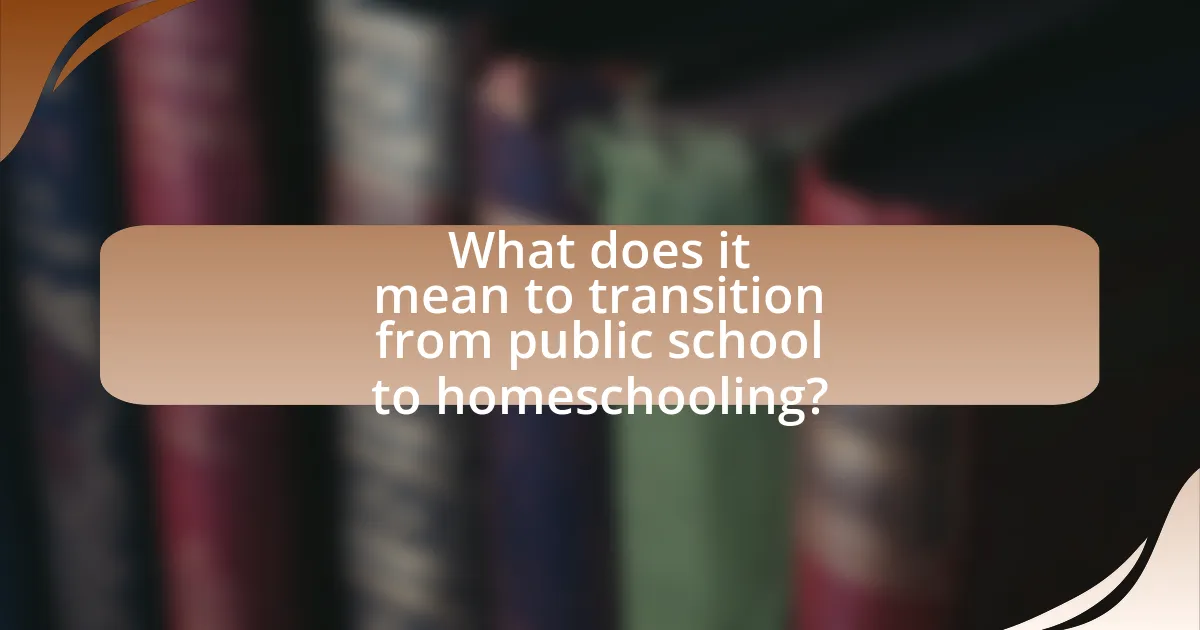The article focuses on the process of transitioning from public school to homeschooling, detailing the responsibilities parents assume in creating a tailored educational experience for their children. It outlines essential preparation steps, including understanding local homeschooling laws, assessing a child’s learning style, and establishing a structured learning environment. The article also addresses potential challenges, such as managing time and socialization concerns, and emphasizes the importance of support systems and resources for a successful transition. Additionally, it provides practical tips for creating effective routines and avoiding common pitfalls during the homeschooling journey.

What does it mean to transition from public school to homeschooling?
Transitioning from public school to homeschooling means shifting a child’s education from a traditional school setting to a home-based learning environment. This process involves parents taking on the responsibility of designing and implementing an educational curriculum tailored to their child’s needs, which can include selecting educational materials, setting schedules, and assessing progress. Research indicates that homeschooling can offer personalized learning experiences, allowing for flexibility in teaching methods and pacing, which may lead to improved academic outcomes for some students.
How can families prepare for the transition to homeschooling?
Families can prepare for the transition to homeschooling by establishing a structured learning environment and creating a personalized curriculum. This involves assessing the child’s learning style and interests to tailor educational materials and activities accordingly. Research indicates that children benefit from a consistent routine, which can enhance their focus and engagement in learning. Additionally, families should familiarize themselves with local homeschooling laws and resources, as regulations vary by state, ensuring compliance and access to support networks. Engaging with other homeschooling families can provide valuable insights and encouragement during the transition.
What are the initial steps to consider before making the switch?
The initial steps to consider before making the switch from public school to homeschooling include researching local homeschooling laws and regulations, assessing your child’s learning style and needs, and creating a structured plan for curriculum and daily schedules. Understanding the legal requirements is crucial, as each state has different regulations regarding homeschooling, which can include notification to the school district or submitting an educational plan. Evaluating your child’s learning preferences helps in selecting the most effective teaching methods and materials. Finally, developing a comprehensive plan ensures that educational goals are met and provides a framework for daily activities, which is essential for a successful transition.
How can families assess their readiness for homeschooling?
Families can assess their readiness for homeschooling by evaluating their educational goals, resources, and commitment levels. First, they should define their educational objectives, such as the desired outcomes for their children’s learning and development. Next, families need to consider the availability of resources, including curriculum materials, learning environments, and support systems, which are essential for effective homeschooling. Additionally, assessing the family’s commitment involves understanding the time and effort required to facilitate a successful homeschooling experience. Research indicates that families who engage in thorough planning and self-reflection are more likely to succeed in transitioning to homeschooling, as they can identify potential challenges and address them proactively.
What challenges might arise during the transition?
Challenges that might arise during the transition from public school to homeschooling include adjusting to a new educational structure, managing time effectively, and addressing socialization concerns. The shift from a structured environment to a more flexible one can create difficulties in establishing a consistent routine, which is essential for effective learning. Additionally, parents may struggle with curriculum selection and ensuring that educational standards are met, as they take on the role of the primary educator. Socialization can also be a significant challenge, as children may miss interactions with peers, necessitating proactive efforts to engage them in community activities or homeschooling groups. These challenges are supported by research indicating that families often face difficulties in maintaining educational rigor and social connections during such transitions.
How can parents address emotional responses from children?
Parents can address emotional responses from children by actively listening and validating their feelings. This approach fosters an environment where children feel safe to express their emotions, which is crucial during transitions like moving from public school to homeschooling. Research indicates that children who feel understood are more likely to develop emotional resilience, as highlighted in a study published in the Journal of Child Psychology and Psychiatry, which found that emotional validation can significantly reduce anxiety and improve coping strategies in children. By engaging in open conversations and providing reassurance, parents can effectively support their children through emotional challenges associated with such transitions.
What logistical issues should families anticipate?
Families should anticipate several logistical issues when transitioning from public school to homeschooling, including curriculum selection, scheduling, and resource allocation. Selecting an appropriate curriculum requires research to ensure it meets educational standards and aligns with the family’s educational goals. Scheduling involves creating a daily routine that accommodates learning, extracurricular activities, and family commitments, which can be challenging to balance. Additionally, families must consider resource allocation, such as budgeting for educational materials, technology, and potential extracurricular programs, which can strain finances if not planned properly. These logistical challenges are common among families making this transition, as evidenced by surveys indicating that 60% of homeschooling families report difficulties in managing time and resources effectively.

What are the key factors to consider when transitioning to homeschooling?
The key factors to consider when transitioning to homeschooling include understanding legal requirements, selecting an appropriate curriculum, assessing the child’s learning style, and establishing a structured schedule. Legal requirements vary by state, with some requiring notification or curriculum approval, which is essential for compliance. Choosing a curriculum that aligns with educational goals and the child’s interests is crucial for effective learning. Recognizing the child’s unique learning style helps tailor the educational approach, enhancing engagement and retention. Finally, creating a structured schedule fosters discipline and consistency, which are vital for a successful homeschooling experience.
How does the choice of curriculum impact the transition?
The choice of curriculum significantly impacts the transition from public school to homeschooling by determining the educational structure and learning outcomes. A well-aligned curriculum can facilitate a smoother adjustment by providing clear learning objectives and resources that match the student’s previous educational experiences. For instance, research indicates that curricula designed for homeschooling often emphasize flexibility and personalized learning, which can help students adapt more easily to a self-directed learning environment. Additionally, a curriculum that incorporates familiar subjects and teaching methods can reduce anxiety and enhance engagement during the transition, as evidenced by studies showing that students who encounter continuity in their learning approach tend to perform better academically and emotionally during such shifts.
What types of homeschooling curricula are available?
There are several types of homeschooling curricula available, including traditional, online, eclectic, and unschooling approaches. Traditional curricula often follow a structured format similar to public schools, providing textbooks and lesson plans for each subject. Online curricula utilize digital platforms for instruction, offering interactive lessons and resources. Eclectic homeschooling combines various methods and materials tailored to the child’s needs and interests, allowing for flexibility in learning. Unschooling emphasizes child-led learning, where students explore subjects based on their curiosity and interests rather than a set curriculum. Each type caters to different educational philosophies and family preferences, providing diverse options for homeschooling families.
How can families choose the right curriculum for their child?
Families can choose the right curriculum for their child by assessing their child’s learning style, interests, and educational goals. Understanding whether a child thrives in a structured environment or prefers a more flexible approach is crucial; for instance, visual learners may benefit from curricula that incorporate multimedia resources, while kinesthetic learners might excel with hands-on activities. Additionally, families should research various curricula options, such as traditional, Montessori, or unschooling methods, to find one that aligns with their child’s needs. According to the National Center for Education Statistics, over 3.7 million students were homeschooled in the United States in 2020, indicating a growing trend that emphasizes the importance of personalized education. By evaluating these factors and considering feedback from other homeschooling families, parents can make informed decisions that best support their child’s educational journey.
What role does support play in a successful transition?
Support plays a crucial role in a successful transition from public school to homeschooling by providing emotional, logistical, and educational resources. Emotional support helps families cope with the changes and uncertainties associated with this shift, fostering resilience and confidence. Logistical support, such as access to homeschooling networks and resources, facilitates the practical aspects of the transition, ensuring that families have the necessary tools and information. Educational support, including guidance from experienced homeschoolers or educators, enhances the learning experience and helps parents effectively tailor their teaching methods to their children’s needs. Research indicates that families with strong support systems report higher satisfaction and better educational outcomes during the transition to homeschooling.
How can families find homeschooling support groups?
Families can find homeschooling support groups by utilizing online platforms, local community resources, and social media networks. Online platforms such as Facebook and Meetup often host groups specifically for homeschooling families, allowing for easy connection and communication. Local community resources, including libraries and educational co-ops, frequently provide information about nearby support groups. Additionally, websites like Homeschool.com and the National Home Education Research Institute offer directories of support groups across various regions, facilitating access to resources and community connections.
What resources are available for new homeschooling families?
New homeschooling families can access a variety of resources to facilitate their transition, including online curricula, local homeschooling groups, and educational websites. Online curricula, such as Khan Academy and Time4Learning, provide structured lessons and materials tailored for different grade levels. Local homeschooling groups offer community support, networking opportunities, and shared resources, which can be found through platforms like Meetup or Facebook. Additionally, educational websites like Homeschool.com and the National Home Education Research Institute provide valuable information, articles, and forums for new homeschooling families to explore best practices and connect with experienced homeschoolers.

How can families ensure a smooth transition to homeschooling?
Families can ensure a smooth transition to homeschooling by creating a structured plan that includes setting clear educational goals, establishing a daily routine, and selecting appropriate curricula. Research indicates that families who outline specific objectives for their children’s education experience less stress and greater satisfaction during the transition. Additionally, maintaining open communication among family members and involving children in the decision-making process fosters a supportive learning environment. Studies show that children who feel included in their educational choices are more engaged and motivated, which contributes to a successful homeschooling experience.
What strategies can help ease the transition process?
To ease the transition process from public school to homeschooling, families can implement structured planning, gradual integration, and open communication. Structured planning involves creating a detailed curriculum that aligns with the child’s learning style and interests, ensuring a smooth educational shift. Gradual integration allows children to adjust by starting with familiar subjects before introducing new ones, which can reduce anxiety and build confidence. Open communication between parents and children fosters a supportive environment, enabling children to express their feelings and concerns about the transition. Research indicates that families who engage in these strategies report higher satisfaction and smoother transitions, as they address both educational and emotional needs effectively.
How can families create a structured learning environment at home?
Families can create a structured learning environment at home by establishing a dedicated learning space, setting a consistent daily schedule, and implementing clear rules and expectations. A designated area for learning minimizes distractions and signals to children that it is time to focus on education. Research indicates that structured routines enhance children’s academic performance and emotional well-being, as consistent schedules help them develop self-discipline and time management skills. Additionally, setting specific goals and regularly reviewing progress can further reinforce a productive learning atmosphere.
What daily routines can support effective homeschooling?
Establishing a structured daily routine is essential for effective homeschooling. A consistent schedule that includes dedicated time for lessons, breaks, and extracurricular activities helps maintain focus and discipline. Research indicates that children thrive in environments with predictable routines, as it fosters a sense of security and enhances learning outcomes. For instance, a study published in the Journal of Educational Psychology found that students with structured daily schedules showed improved academic performance and reduced anxiety levels. Incorporating time for physical activity, hands-on projects, and family discussions further enriches the homeschooling experience, promoting holistic development.
What are some common pitfalls to avoid during the transition?
Common pitfalls to avoid during the transition from public school to homeschooling include inadequate planning, lack of structure, and insufficient communication. Inadequate planning can lead to gaps in education, as families may not thoroughly research curriculum options or learning styles. Lack of structure often results in inconsistent learning schedules, which can hinder a child’s educational progress. Insufficient communication among family members can create misunderstandings about educational goals and responsibilities, leading to frustration and conflict. Addressing these pitfalls is crucial for a successful transition to homeschooling.
How can families prevent burnout during the homeschooling process?
Families can prevent burnout during the homeschooling process by establishing a structured routine that balances academic work with breaks and leisure activities. A consistent schedule helps manage expectations and reduces stress for both parents and children. Research indicates that incorporating regular breaks can enhance focus and retention, as studies show that short, frequent breaks improve overall productivity and learning outcomes. Additionally, families should prioritize open communication, allowing children to express their feelings about the homeschooling experience, which can help identify stressors early and address them effectively.
What mistakes should families be aware of when starting homeschooling?
Families should be aware of several common mistakes when starting homeschooling, including lack of structure, inadequate planning, and insufficient understanding of educational requirements. Lack of structure can lead to inconsistent learning, as children may not have a clear schedule or routine, which is essential for effective education. Inadequate planning often results in families not covering essential subjects or failing to set realistic goals, hindering the educational process. Additionally, insufficient understanding of educational requirements can lead to non-compliance with state laws, which may vary significantly, resulting in legal issues. These mistakes can negatively impact the homeschooling experience and the educational outcomes for children.
What practical tips can help families transition smoothly to homeschooling?
To transition smoothly to homeschooling, families should establish a structured daily routine that includes dedicated learning times, breaks, and extracurricular activities. This routine helps create a sense of normalcy and discipline similar to traditional schooling. Research indicates that children thrive in environments with consistent schedules, as it fosters better focus and time management skills. Additionally, families should utilize resources such as online curricula, local homeschooling groups, and educational materials to support their teaching efforts. Engaging with other homeschooling families can provide valuable insights and emotional support, making the transition less isolating.










